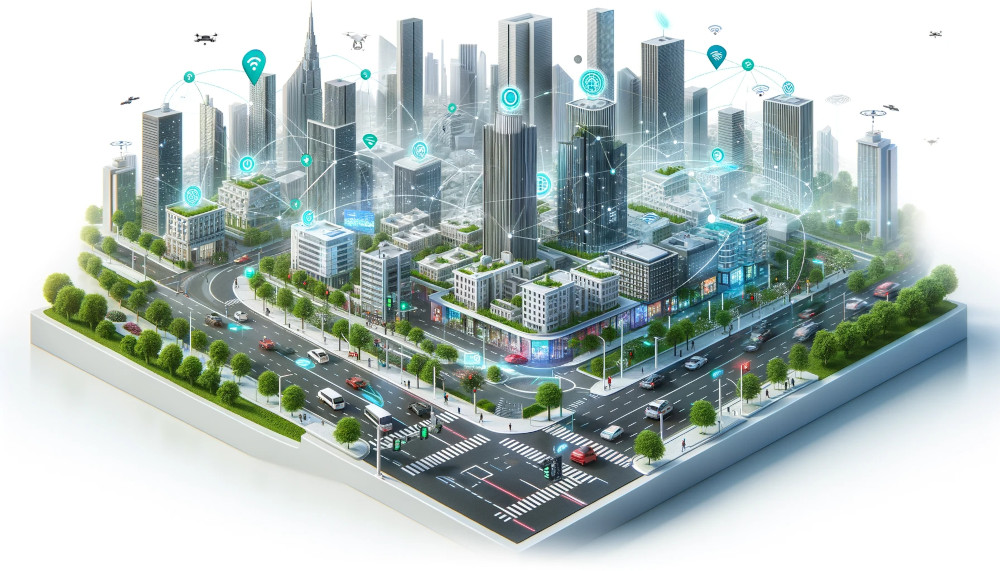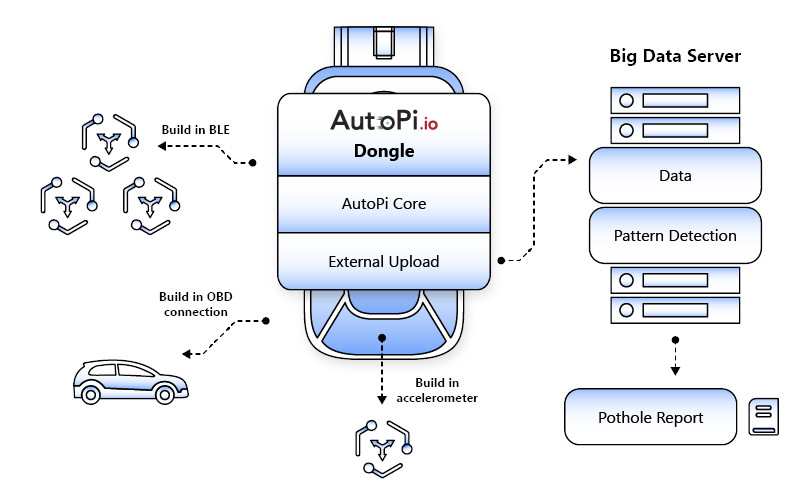Welcome to the fascinating world of Smart Cities – urban hubs of the future where innovation meets daily life. Did you know that in 2025, it's estimated that over 26 cities around the globe will be classified as 'smart'? This exciting evolution is not just a glimpse into the future, but a reality unfolding before our eyes.
Smart Cities represent more than just technological advancements; they embody a vision of sustainability, efficiency, and enhanced quality of life. As we stand on the brink of this urban revolution, our guide offers a window into this evolving world. We'll unravel the layers of what makes a city 'smart' and provide insights into the foundational elements that are paving the way for more connected, intelligent, and livable cities.
Join us as we delve into the intricate tapestry of technologies and strategies that are transforming our urban landscapes in the 21st century, one innovative step at a time.
What is a Smart City?
A Smart City is an urban area that uses digital technology and information and communication technologies (ICT) to enhance performance and well-being, to reduce costs and resource consumption, and to engage more effectively and actively with its citizens. At its core, a Smart City harnesses data and technology to improve the infrastructure and operations of the city, aiming to create a more sustainable and livable urban environment.
The concept of a Smart City goes beyond the mere implementation of technology. It's about a new way of thinking and operating, where every component of the city is interconnected and optimized for maximum efficiency and effectiveness. This involves a shift from traditional city development, focusing on people-centric and technology-enhanced approaches to urban planning.
In the heart of a Smart City lies its ability to harness and utilize data efficiently. Let's break down how these cities use technology to gather and apply data in ways that transform urban living:
-
Smart Cities use electronic and digital technologies extensively.
-
Data sources include city sensors and electronic devices.
-
Residents themselves are key sources of data.
-
It's not just about data collection.
-
The focus is on using data to improve city services.
-
Data helps in reducing waste.
-
It enables better decision-making in urban management.
-
Effective data use is what defines a Smart City.
Smart Cities represents a new paradigm in urban development. It's an interconnected, intelligent network of technologies and strategies working in unison to enhance the quality of urban living, striving for economic, social, and environmental sustainability.
As we continue, we will delve deeper into how this concept is being realized, the technologies involved, and the multitude of benefits it brings to our urban spaces.
-
The Meaning of Smart City
-
A Smart City represents an advanced urban environment, where integrated technology optimizes city functions and elevates the quality of life for its inhabitants.
Which Technologies Are Shaping Smart Cities?
Understanding what makes a Smart City involves recognizing the several key technologies that work in concert to create efficient, safe, and sustainable urban environments.
These technologies are not standalone solutions but are integral parts of an integrated system that enhances the quality of urban living. Let's delve into some of these technologies:
-
IoT (Internet of Things): IoT is the backbone of Smart City infrastructure, involving interconnected devices that collect and share data, allowing for real-time resource management, improved energy use, and enhanced public safety.
-
Telematics: Utilized in vehicle tracking, telematics combines GPS, diagnostics, and monitoring sensors for optimized transportation management, contributing to reduced congestion and improved road safety.
-
Smart Cars: Equipped with technology for communication, smart cars enhance traffic flow, safety, and parking efficiency, revolutionizing the urban driving experience.
-
Smart Traffic Systems: These systems use sensors and AI to dynamically manage traffic flow, reducing congestion and the environmental impact of traffic.
-
Urban Sensors: Distributed throughout the city, these sensors monitor various aspects like air quality, noise levels, and pedestrian traffic, providing data for informed urban planning and living environment enhancement.
-
Energy Management Systems: Smart Cities employ advanced systems for efficient energy distribution and consumption, utilizing renewable sources and smart grid technology to optimize energy usage and reduce waste.
-
Digital Payment Systems: These systems facilitate seamless and cashless transactions for public services, including transportation fares, parking fees, and recreational activities, enhancing convenience for residents and visitors.
-
Smart Lighting: Employing LED and IoT technology, smart lighting systems adjust based on natural light availability and occupancy, significantly reducing energy consumption and costs.
-
E-Governance Services: Digital platforms that allow citizens to access city services online, improving efficiency, transparency, and citizen engagement in municipal matters.
-
Water Management Systems: Innovative technologies for monitoring and managing water usage and quality, ensuring sustainable water resources management and conservation.
Each of these technologies plays a vital role in shaping Smart Cities. They collectively create an ecosystem where technology not only serves the immediate needs of the residents but also paves the way for a more sustainable, efficient and livable future.

What is a Smart City Example?
Building on our understanding of the technologies that drive Smart Cities, let's explore some real-world examples. These cities are not just theoretical concepts but living, breathing embodiments of smart technology at work. They showcase how integrated systems and innovative solutions can reshape urban living.
Here are five such cities, followed by three conceptual smart city projects:
Current Smart Cities
-
Singapore
-
Started: Smart Nation initiative began around 2014.
-
Features: Extensive IoT integration for public services, smart traffic solutions reducing congestion, e-government services, and sustainable urban practices like smart water management.
-
Expected to be ongoing: Continually evolving with the latest in smart technology.
-
-
Dubai, UAE
-
Started: Smart Dubai initiative launched in 2014.
-
Features: Blockchain for secure transactions, AI-driven traffic and safety systems, smart energy grid, and digitalizing most government services for efficiency and transparency.
-
Expected to be ongoing: Continuously innovating to enhance urban life and happiness.
-
-
Barcelona, Spain
-
Started: Smart city projects initiated in the early 2010s.
-
Features: Pioneering in smart street lighting and waste collection, extensive network of IoT sensors, integrated transport system, and initiatives for citizen engagement through technology.
-
Expected to be ongoing: Expanding its smart city initiatives to further enhance connectivity and citizen quality of life.
-
-
New York City, USA
-
Started: Smart city initiatives have been evolving since the mid-2010s.
-
Features: Deployment of LinkNYC kiosks providing free Wi-Fi, environmental sensors for air quality monitoring, smart building technologies for energy efficiency, and advanced urban analytics for policy-making.
-
Expected to be ongoing: Striving to integrate more smart solutions in urban infrastructure.
-
-
Copenhagen, Denmark
-
Started: Smart city projects began gaining traction in the early 2010s.
-
Features: World leader in cycling solutions and smart bike paths, ambitious smart energy grid with a focus on renewables, advanced water management systems, and smart traffic lights reducing commute times.
-
Expected to be ongoing: Focused on achieving carbon neutrality by 2025 through ongoing smart initiatives.
-
Conceptual Smart City Projects
-
The Line, Neom, Saudi Arabia
-
Announced: 2021
-
Concept: A car-free linear city, relying on AI for services and governance, powered entirely by renewable energy, with a focus on enhancing natural ecosystems.
-
Expected Completion: Envisioned for 2030, with broader goals set for 2045.
-
-
Bill Gates' Smart City in Arizona, USA
-
Announced: 2017
-
Concept: Planned as a hub for high-speed networks, autonomous logistics, data centers, new manufacturing technologies, and renewable energy sources.
-
Expected Completion: Still in development, with a long-term vision for integrating next-gen urban technologies.
-
-
Toyota's Woven City, Japan
-
Announced: 2020
-
Concept: Aimed to be a fully connected ecosystem powered by hydrogen fuel cells, serving as a testing ground for autonomous vehicles, robotics, smart home technology, and AI-driven services.
-
Expected Completion: Initial phases projected for the mid-2020s, with ongoing development and expansion.
-
These enhanced descriptions provide a more comprehensive overview of the features and technological advancements in each of the Smart Cities and conceptual projects, highlighting their unique approaches to integrating technology into the urban fabric.

Key Takeaways
As we conclude our exploration of Smart Cities and the intricate web of technologies that power them, it's important to reflect on the key insights and lessons learned from these advanced urban landscapes.
Here are the key takeaways from our journey into the world of Smart Cities:
-
Integration is Key: The effectiveness of a Smart City lies in integrating technologies like IoT, telematics, and smart traffic systems to create sustainable urban environments.
-
Focus on Citizens: Smart Cities prioritize enhancing the quality of life for residents through improved services and sustainable practices.
-
Adaptable and Evolving: Smart Cities are dynamic, constantly evolving with technological advancements to improve urban living.
-
Data-Driven Decisions: Utilizing data analytics is crucial for efficient city management and informed decision-making in Smart Cities.
-
Commitment to Sustainability: Energy efficiency and environmental stewardship are central to the ethos of Smart Cities.
-
Security and Privacy: Balancing technological innovation with the security and privacy of citizens' data is a critical aspect of Smart City management.
-
Learning from Examples: Existing Smart Cities and conceptual projects provide valuable lessons for future urban development strategies.
-
Customized Approaches: Each Smart City adopts unique solutions that reflect its specific challenges and cultural context.
These takeaways encapsulate the essence of Smart Cities, highlighting their potential to revolutionize urban living while also acknowledging the challenges and responsibilities they entail.





